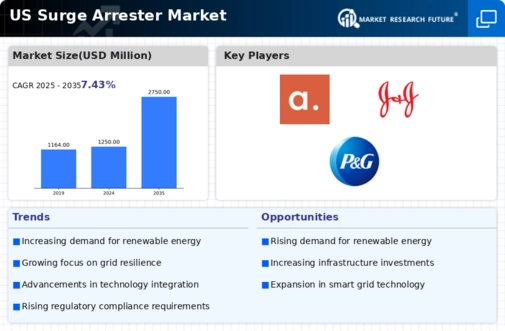Emerging Renewable Energy Projects
The surge arrester market is experiencing growth due to the emergence of renewable energy projects across the United States. As the country shifts towards sustainable energy sources, such as solar and wind, the need for effective surge protection becomes paramount. In 2025, investments in renewable energy are projected to reach $500 billion, leading to an increased demand for surge arresters to protect solar panels and wind turbines from electrical surges. These renewable installations are often exposed to unpredictable weather conditions, making them susceptible to voltage spikes. Consequently, the surge arrester market is likely to expand as project developers and operators prioritize the protection of their renewable energy assets, ensuring operational reliability and longevity.
Expansion of Smart Grid Technologies
The surge arrester market is being influenced by the expansion of smart grid technologies in the United States. As utilities adopt advanced metering infrastructure and automated systems, the need for robust surge protection becomes increasingly critical. Smart grids are designed to enhance the reliability and efficiency of power distribution, but they also introduce new vulnerabilities to electrical systems. In 2025, the integration of smart grid technologies is projected to increase the demand for surge arresters by around 20%. This growth is driven by the necessity to protect sensitive electronic equipment from voltage spikes that can occur during grid fluctuations. As the transition to smart grids continues, the surge arrester market is expected to see substantial growth, ensuring that modern electrical systems are adequately protected.
Rising Adoption of Electric Vehicles
The surge arrester market is likely to benefit from the rising adoption of electric vehicles (EVs) in the United States. As more consumers and businesses transition to EVs, the demand for charging infrastructure is increasing, which necessitates the implementation of surge protection devices. In 2025, the number of public charging stations is expected to exceed 100,000, creating a significant opportunity for surge arresters to protect these installations from electrical surges. Additionally, the integration of EVs into the power grid introduces new challenges, including potential voltage fluctuations. Therefore, the surge arrester market is positioned to grow as stakeholders recognize the importance of safeguarding charging stations and related infrastructure from transient overvoltages.
Increasing Infrastructure Investments
The surge arrester market is experiencing growth due to increasing investments in infrastructure across the United States. Government initiatives aimed at modernizing electrical grids and enhancing energy efficiency are driving demand for surge protection devices. In 2025, the U.S. government allocated approximately $1 trillion for infrastructure improvements, which includes upgrading power systems. This investment is likely to bolster the surge arrester market as utilities and industries seek to protect their assets from voltage spikes. Furthermore, the need for reliable power supply in urban areas is pushing the adoption of surge arresters, ensuring that electrical systems remain operational during adverse conditions. As infrastructure projects progress, the surge arrester market is expected to expand, providing essential protection against transient overvoltages.
Growing Awareness of Electrical Safety
There is a notable increase in awareness regarding electrical safety among consumers and businesses, which is positively impacting the surge arrester market. Educational campaigns and safety regulations have highlighted the risks associated with electrical surges, prompting organizations to invest in protective measures. In 2025, it is estimated that the market for surge protection devices will grow by approximately 15% as more entities recognize the importance of safeguarding their electrical systems. This heightened awareness is particularly evident in sectors such as manufacturing, healthcare, and data centers, where equipment failure can lead to significant financial losses. Consequently, the surge arrester market is likely to benefit from this trend, as more stakeholders prioritize safety and reliability in their electrical installations.














Leave a Comment